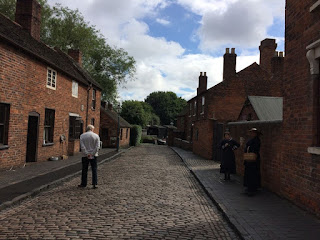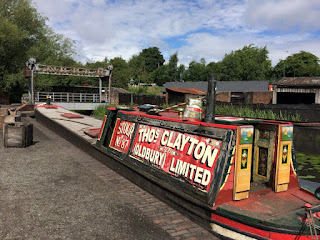A sunny start to the day, moored outside the Dudley Black Country Museum.
After breakfast we set off down to the Dudley Canal and Tunnel Trust's brand new multi-million pound visitors' centre. M remarked that it looked a bit like a tunnel ventilation shaft - or maybe a canal "round house". The north portal of the Dudley Tunnel is visible - but it is far too low to allow MM to go through! A trip boat operates tours into the tunnel and we did that trip when we were here four years ago. Sadly, the new visitors' centre was a bit underwhelming - a rather sparsely stocked shop and a café upstairs. Not very inspiring. We felt that much more could have been made of it.
The Museum site, on the other side of the canal, opens at 10:00am and we were there as soon as the gates opened - just like when we were here four years ago.
Where to start? There is so much to see. M's favourite is the cobbled street of old cottages and small workshops with their warren of little back passages and each with its own fully stocked back garden. The houses are all fitted out as they were in their time, which varies from the early 1800s to the Second World War.
There are also many shops, including this ironmongers who seemed to specialise in "fork handles". The two Ronnies would have appreciated that.
Many of the cottages have costumed staff in them who can tell you the history of the house. Behind one house was a typical "chain making" workshop where the woman of the house made light chain twelve hours a day, six days a week - helped by children as young as five. This lady was demonstrating in her tiny workshop. She said that an experienced chain maker could make 60 links and hour or one a minute!
Nearby Cradley Heath was the country's chain making centre where, in the 1800s 95% of the country's chain was made, much of which was exported. The women made the light chain in small workshops behind their houses, as above, while the men made larger chain, but still in small workshops behind their houses.
Round the corner, this man was demonstrating making larger chain. He said that an experienced chain maker would make 30 links an hour, or one every two minutes!
He said that each link of the chain for the Titanic's anchor was made from a 6in diameter bar and weighed a quarter of a ton.
The sweet shop still has its original moulds and presses for making different shaped sweets.
We don't normally eat sweets but we did buy an almond tart for our tea from the baker's shop next door. It was delicious!
While most of the buildings have been moved here from elsewhere and re-built, three industries are in their original locations - the coal mine, the lime kilns and the canal basin. The coal mine is a drift mine where the coal seam starts at the surface and runs at an angle underground. We took the guided tour, following the guide with very dim torches emulating candles to light our way. It was fascinating and, at times, very dark!
The canal arm, that leads up to the lime kilns, houses several historic working narrow boats including iconic steam driven nb "President" with its butty "Kildare", which are based here when not out on the cut going to shows. Nb "Stour" was the last "Fellows Morton and Clayton" narrowboat to carry a commercial load. Now it is very much in need of refurbishment and efforts are being made to raise the necessary funds.
"Stour" was built to carry the tar residue from the process to make coke and gas from coal.
Lunch was varied! R had coffee and cake in the Working Men's Institute while M had traditional fish and chips from the renowned shop of "Hobbs & Sons". Very good too!
As darkness fell, we noticed that the street lamp overlooking MM was a proper old gas lamp! Not often that you see a real gas lamp - it gave a lovely soft light.
Today, MM had the day off.












No comments:
Post a Comment